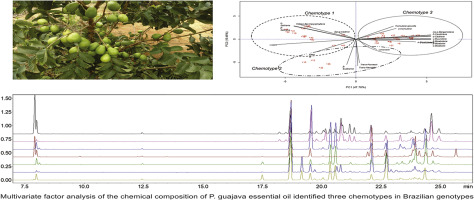当前位置:
X-MOL 学术
›
Phytochemistry
›
论文详情
Our official English website, www.x-mol.net, welcomes your feedback! (Note: you will need to create a separate account there.)
Chemotype diversity of Psidium guajava L.
Phytochemistry ( IF 3.8 ) Pub Date : 2018-09-01 , DOI: 10.1016/j.phytochem.2018.06.006 Tércio da Silva de Souza , Marcia Flores da Silva Ferreira , Luciano Menini , Jaqueline Rodrigues Cindra de Lima Souza , Carolina de Oliveira Bernardes , Adésio Ferreira
Phytochemistry ( IF 3.8 ) Pub Date : 2018-09-01 , DOI: 10.1016/j.phytochem.2018.06.006 Tércio da Silva de Souza , Marcia Flores da Silva Ferreira , Luciano Menini , Jaqueline Rodrigues Cindra de Lima Souza , Carolina de Oliveira Bernardes , Adésio Ferreira

|
The essential oil of Psidium guajava L. has been studied for pharmacological and industrial purposes, without considering the plant's genotype regarding the heterogeneity of its composition. The present study aimed to characterize the chemotype diversity of the essential oil extracted from the leaves of 22 genotypes of P. guajava grown in two different environments in the state of Espírito Santo, Brazil, and to identify the different chemical markers present in these plants. Essential oil from the leaves of the P. guajava genotypes was extracted by hydrodistillation, and its chemical composition was analyzed by gas chromatography-flame ionization detection (GC-FID) and gas chromatography-mass spectrometry (GC-MS). Thirty-three compounds were identified, comprising 87.5-99.0% of the total composition, with a prevalence of sesquiterpenes in all samples. The major compounds identified consisted of (E)-trans-Caryophyllene, α-Humulene, trans-Nerolidol, β-Bisabolene, β-Bisabolol, and Hinesol, the first of which was identified as a possible chemical marker for the species. Multivariate factor analysis of the chemical composition of P. guajava oil identified three chemotypes: Commercial - PAL, SEC, PS, PET, C7, C11, and C17MI, characterized by high levels of β-Selinene, α-Selinene, Hinesol, and 14-hydroxy-epi-(E)-caryophyllene, with β-Selinene and α-Selinene as the chemical markers; C10 and C13, exhibiting high levels of Elemol, trans-Nerolidol, trans-β-Eudesmol, and (2Z, 6Z)-Farnesol, which were indicated as chemical markers, and Cortibel - C1, C2, C3, C4, C5, C6, C8, C9, C12, C14, C15, C16, C17LI, which retained high levels of α-Cedrene, cis-α-Bergamotene, α-Humulene, Humulene epoxide, epi-α-Cadinol, β-Bisabolol, and α-Bisabolol, with β-Bisabolol and α-Bisabolol as the chemical markers. The use of guava genotypes with different chemotypes, that are agronomically favorable to fruit production and essential oil exploitation adds value to the crop and renders it more sustainable. Given guava crops produce large amounts of leaf biomass, resulting from successive prunings, the extraction of their essential oil, which retains commercially valuable compounds, can be feasible.
中文翻译:

Psidium guajava L 的化学型多样性。
Psidium guajava L. 的精油已被研究用于药理和工业目的,而没有考虑植物基因型及其成分的异质性。本研究旨在表征从巴西圣埃斯皮里图州两种不同环境中生长的 22 种番石榴基因型叶子中提取的精油的化学型多样性,并确定这些植物中存在的不同化学标记。采用水蒸馏法从番石榴基因型叶片中提取精油,并通过气相色谱-火焰离子化检测(GC-FID)和气相色谱-质谱(GC-MS)分析其化学成分。确定了 33 种化合物,占总成分的 87.5-99.0%,倍半萜烯在所有样品中的普遍存在。鉴定的主要化合物包括 (E)-反式石竹烯、α-葎草烯、反式橙花油醇、β-红没药烯、β-红没药醇和 Hinesol,其中第一个被鉴定为该物种的可能化学标记。对番石榴油化学成分的多变量因素分析确定了三种化学类型:商业 - PAL、SEC、PS、PET、C7、C11 和 C17MI,其特征在于高水平的 β-Selinene、α-Selinene、Hinesol 和 14 -羟基-表观-(E)-石竹烯,以β-Selinene和α-Selinene为化学标志物;C10 和 C13,表现出高水平的 Elemol、反式橙花醇、反式-β-Eudesmol 和 (2Z, 6Z)-Farnesol,它们被指示为化学标记物,以及 Cortibel - C1、C2、C3、C4、C5、C6 、C8、C9、C12、C14、C15、C16、C17LI,它们保留了高水平的 α-雪松烯,顺式-α-佛手柑、α-葎草烯、环氧化物葎草烯、epi-α-卡地诺、β-红没药醇和α-红没药醇,以β-红没药醇和α-红没药醇为化学标记物。使用具有不同化学型的番石榴基因型,这些基因型在农艺上有利于水果生产和精油开采,增加了作物的价值并使其更具可持续性。鉴于番石榴作物通过连续修剪产生大量叶子生物量,因此提取其精油(保留有商业价值的化合物)是可行的。在农艺上有利于水果生产和精油开采的植物增加了作物的价值并使其更具可持续性。鉴于番石榴作物通过连续修剪产生大量叶子生物量,因此提取其精油(保留有商业价值的化合物)是可行的。在农艺上有利于水果生产和精油开采的植物增加了作物的价值并使其更具可持续性。鉴于番石榴作物通过连续修剪产生大量叶子生物量,因此提取其精油(保留有商业价值的化合物)是可行的。
更新日期:2018-09-01
中文翻译:

Psidium guajava L 的化学型多样性。
Psidium guajava L. 的精油已被研究用于药理和工业目的,而没有考虑植物基因型及其成分的异质性。本研究旨在表征从巴西圣埃斯皮里图州两种不同环境中生长的 22 种番石榴基因型叶子中提取的精油的化学型多样性,并确定这些植物中存在的不同化学标记。采用水蒸馏法从番石榴基因型叶片中提取精油,并通过气相色谱-火焰离子化检测(GC-FID)和气相色谱-质谱(GC-MS)分析其化学成分。确定了 33 种化合物,占总成分的 87.5-99.0%,倍半萜烯在所有样品中的普遍存在。鉴定的主要化合物包括 (E)-反式石竹烯、α-葎草烯、反式橙花油醇、β-红没药烯、β-红没药醇和 Hinesol,其中第一个被鉴定为该物种的可能化学标记。对番石榴油化学成分的多变量因素分析确定了三种化学类型:商业 - PAL、SEC、PS、PET、C7、C11 和 C17MI,其特征在于高水平的 β-Selinene、α-Selinene、Hinesol 和 14 -羟基-表观-(E)-石竹烯,以β-Selinene和α-Selinene为化学标志物;C10 和 C13,表现出高水平的 Elemol、反式橙花醇、反式-β-Eudesmol 和 (2Z, 6Z)-Farnesol,它们被指示为化学标记物,以及 Cortibel - C1、C2、C3、C4、C5、C6 、C8、C9、C12、C14、C15、C16、C17LI,它们保留了高水平的 α-雪松烯,顺式-α-佛手柑、α-葎草烯、环氧化物葎草烯、epi-α-卡地诺、β-红没药醇和α-红没药醇,以β-红没药醇和α-红没药醇为化学标记物。使用具有不同化学型的番石榴基因型,这些基因型在农艺上有利于水果生产和精油开采,增加了作物的价值并使其更具可持续性。鉴于番石榴作物通过连续修剪产生大量叶子生物量,因此提取其精油(保留有商业价值的化合物)是可行的。在农艺上有利于水果生产和精油开采的植物增加了作物的价值并使其更具可持续性。鉴于番石榴作物通过连续修剪产生大量叶子生物量,因此提取其精油(保留有商业价值的化合物)是可行的。在农艺上有利于水果生产和精油开采的植物增加了作物的价值并使其更具可持续性。鉴于番石榴作物通过连续修剪产生大量叶子生物量,因此提取其精油(保留有商业价值的化合物)是可行的。


























 京公网安备 11010802027423号
京公网安备 11010802027423号